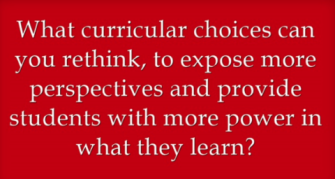
Since knowledge is power and how we present and what we present to students is derived from a variety of different places that don’t always tell the whole story, it is imperative that we start including students in these powerful curricular decisions.
For too long, it was textbooks that dictated the content that was placed before students. Schools bought textbooks and teachers followed the chapters and units as written. It was the perfect package deal to make everything appear easier for everyone involved.
In the not so distant past, many educational systems have started moving away from packaged curricula, but not nearly enough. Sure they don’t always come in textbooks alone anymore, now they are sold as programs, also prewritten for ease. Schools shop these programs around and hopefully supplement them in order to provide a well-rounded experience for students.
The older students get, once they get into their secondary learning, the content becomes denser and how we choose to expose students to a variety of topics, depending on where we come from, the beliefs and policies of our individual states and own beliefs color how and what we present.
This is a horrible disservice to students.
As our world changes, it is our job to prepare students for a world where they must find truth through the various different versions that present themselves. We can do this by taking an active position of working with students to co-create the curriculum that is taught by providing ample choice and voice into the content and the process of learning.
In so many ways students understand the world younger and younger and we have to empower them to make sense of it in a way that best represents each of their needs. We, as educators, can share our passions, exposing our students to different texts and sources they may not have heard of, but instead of using one version of whatever we present, why not offer a variety and ask them to make meaning as we support them in that effort.
Currently, in my leadership program, I’m taking a curriculum development course for administrators which has sadly confirmed many things I have always believed about the power of curriculum. As a student myself, I had an AP US teacher who started class by telling us everything he would teach us was a lie. It was quite the hook for an 11th grade Social Studies class, but it certainly worked as I remember it to this day. And he was right.
What we did in that class was uncover many truths about our country that weren’t necessarily taught in the mainstream. He didn’t try to indoctrinate us, merely expose us to a variety of different primary sources and asked us to consider different possibilities than what we had always been taught.
Recently on NPR, I heard something about Thomas Jefferson and his heirs and how history sometimes tries to rewrite itself from its clearly ugly and sometimes compromised past. It’s safe to say that Jefferson was a brilliant man and important in the founding and building of our country, but he was also deeply flawed as a person. His narrative being told in only partial truths hurts the integrity of our learning. This is just one example, but hardly not the only one.
It isn’t just in Social Studies classes in the United States or other countries. We all know that history is written by the victors, but there are two sides or more to every story and each of those sides deserves to be heard.
As an English teacher, it wasn’t my job to tell students what authors meant in their writing or what different symbols in texts meant. It was my job to create an atmosphere where my students felt safe to challenge each other’s views and critically view texts from a variety of lenses and then determine personal meaning. This is what curriculum should seek to do, provide ample opportunities for students to read deeply, question thoroughly and explore the world they live in within their own context and the context of others.
When we consider what we teach students, we must ask ourselves why every piece of content is where it is. What is the purpose of the learning? Who owns the learning and how can we empower students more and more to be in charge of what it looks like? It’s their turn, not ours any longer.
How can we engage students in this dialogue at every age as appropriate? Please share